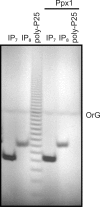Identification of an evolutionarily conserved family of inorganic polyphosphate endopolyphosphatases
- PMID: 21775424
- PMCID: PMC3173201
- DOI: 10.1074/jbc.M111.266320
Identification of an evolutionarily conserved family of inorganic polyphosphate endopolyphosphatases
Abstract
Inorganic polyphosphate (poly-P) consists of just a chain of phosphate groups linked by high energy bonds. It is found in every organism and is implicated in a wide variety of cellular processes (e.g. phosphate storage, blood coagulation, and pathogenicity). Its metabolism has been studied mainly in bacteria while remaining largely uncharacterized in eukaryotes. It has recently been suggested that poly-P metabolism is connected to that of highly phosphorylated inositol species (inositol pyrophosphates). Inositol pyrophosphates are molecules in which phosphate groups outnumber carbon atoms. Like poly-P they contain high energy bonds and play important roles in cell signaling. Here, we show that budding yeast mutants unable to produce inositol pyrophosphates have undetectable levels of poly-P. Our results suggest a prominent metabolic parallel between these two highly phosphorylated molecules. More importantly, we demonstrate that DDP1, encoding diadenosine and diphosphoinositol phosphohydrolase, possesses a robust poly-P endopolyphosphohydrolase activity. In addition, we prove that this is an evolutionarily conserved feature because mammalian Nudix hydrolase family members, the three Ddp1 homologues in human cells (DIPP1, DIPP2, and DIPP3), are also capable of degrading poly-P.
Figures







Similar articles
-
A Novel Inositol Pyrophosphate Phosphatase in Saccharomyces cerevisiae: Siw14 PROTEIN SELECTIVELY CLEAVES THE β-PHOSPHATE FROM 5-DIPHOSPHOINOSITOL PENTAKISPHOSPHATE (5PP-IP5).J Biol Chem. 2016 Mar 25;291(13):6772-83. doi: 10.1074/jbc.M116.714907. Epub 2016 Jan 31. J Biol Chem. 2016. PMID: 26828065 Free PMC article.
-
Polyphosphates and Polyphosphatase Activity in the Yeast Saccharomyces cerevisiae during Overexpression of the DDP1 Gene.Biochemistry (Mosc). 2015 Oct;80(10):1312-7. doi: 10.1134/S0006297915100120. Biochemistry (Mosc). 2015. PMID: 26567575
-
Using native and synthetic genes to disrupt inositol pyrophosphates and phosphate accumulation in plants.Plant Physiol. 2024 Dec 23;197(1):kiae582. doi: 10.1093/plphys/kiae582. Plant Physiol. 2024. PMID: 39474910 Free PMC article.
-
The ring rules the chain - inositol pyrophosphates and the regulation of inorganic polyphosphate.Biochem Soc Trans. 2024 Apr 24;52(2):567-580. doi: 10.1042/BST20230256. Biochem Soc Trans. 2024. PMID: 38629621 Review.
-
Prion propagation and inositol polyphosphates.Curr Genet. 2018 Jun;64(3):571-574. doi: 10.1007/s00294-017-0788-2. Epub 2017 Dec 14. Curr Genet. 2018. PMID: 29243174 Free PMC article. Review.
Cited by
-
Human Prune Regulates the Metabolism of Mammalian Inorganic Polyphosphate and Bioenergetics.Int J Mol Sci. 2023 Sep 8;24(18):13859. doi: 10.3390/ijms241813859. Int J Mol Sci. 2023. PMID: 37762163 Free PMC article.
-
Polyphosphate as a Target for Interference With Inflammation and Thrombosis.Front Med (Lausanne). 2019 Apr 12;6:76. doi: 10.3389/fmed.2019.00076. eCollection 2019. Front Med (Lausanne). 2019. PMID: 31106204 Free PMC article. Review.
-
Extra-phosphoric effects of super dosing phytase on growth performance of pigs is not solely due to release of myo-inositol.J Anim Sci. 2019 Sep 3;97(9):3898-3906. doi: 10.1093/jas/skz232. J Anim Sci. 2019. PMID: 31284292 Free PMC article.
-
Inositol pyrophosphates regulate RNA polymerase I-mediated rRNA transcription in Saccharomyces cerevisiae.Biochem J. 2015 Feb 15;466(1):105-14. doi: 10.1042/BJ20140798. Biochem J. 2015. PMID: 25423617 Free PMC article.
-
Vip1 is a kinase and pyrophosphatase switch that regulates inositol diphosphate signaling.Proc Natl Acad Sci U S A. 2020 Apr 28;117(17):9356-9364. doi: 10.1073/pnas.1908875117. Epub 2020 Apr 17. Proc Natl Acad Sci U S A. 2020. PMID: 32303658 Free PMC article.
References
Publication types
MeSH terms
Substances
Grants and funding
LinkOut - more resources
Full Text Sources
Molecular Biology Databases

